Media | Articles
Return to the mouse-infested truck: This time, success! Well, sort of
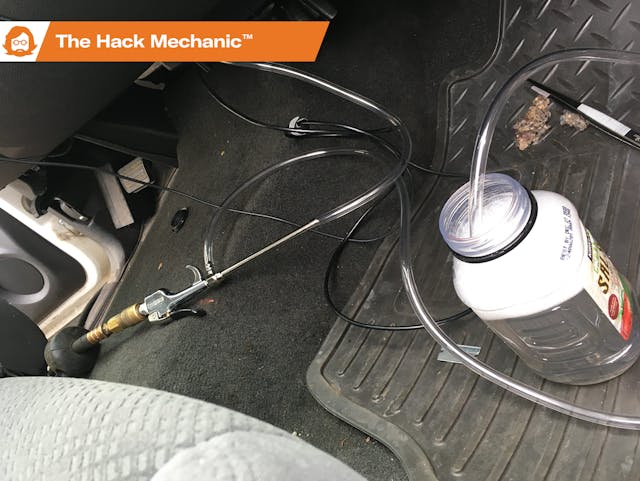
After writing three stories in September about my purchase of an essentially abandoned 2008 Chevy Silverado 3500HD—at a cost of only one-tenth of its book value, largely because it had a mouse infestation problem—some folks might think I couldn’t squeeze one more story out of it.
And some folks would, of course, be wrong because here it is.
In those first three installments, I described buying the truck, replacing the rodent-waste-soaked headliner, then drilling holes in the heater box and performing the equivalent of arthroscopic surgery to remove the mouse nest, extract a mouse carcass, and flush the box with enzyme-based cleaner and water. I did this because removing the heater box to properly disassemble and clean it is reportedly a 10-hour job for a professional (which I am not), and it requires removing the dashboard to do it.
Doing all of that for a passion vehicle is one thing, but I’m simply not willing to do it for an occasionally driven truck. At the conclusion of the third installment, I reported that I turned on the air conditioning, rolled up the windows, removed my mask, felt cold non-rodent-redolent air, declared success, and patted myself on the back for being such a clever so-and-so.
I did, however, make a crucial mistake. And now that we’re rounding the turn from fall and sliding into the frigid arms of winter, it’s a laughably large oops—I never turned on the heat.
Marketplace
Buy and sell classics with confidence
In my defense, it had been a hot summer here in Boston, and windows-up-A/C-on stink-free performance was my success metric. I simply didn’t think about the heater. Hey, I’d de-moused this steal of a truck, the A/C smelled good, I was livin’ the dream. But when the leaves fell, frost coated the windshield, I backed the truck out of the driveway to run to run an errand, and I turned on the heat, I was greeted with a demon stench. It was the heater box’s way of saying that its hosting of a rodent population was not going to be forgotten so easily.
As I described several months ago in the third installment, the “heater box” in any modern car is actually a climate control box containing both the heater core and the A/C evaporator core. A blend door is used to control the intermixing of hot and cold air. The fact that the A/C evaporator core is inside the heater box was, in fact, crucial to my “arthroscopic” success: Evaporator cores naturally sweat (have humidity condense on them), so there’s a drain hole under the core where the condensed moisture can run out. I went into detail on how I bought another heater box, disassembled it, and used it as a reference for where I should drill the holes to extract the mouse nest. As part of that, I discovered that the box is designed with a sloping floor that seemed to ensure that any moisture entering the box anywhere would flow downhill to the evaporator drain. This was why I felt I could simply soak the inside of the box with enzyme-based cleaner, then flood it with water to flush any remaining detritus out.
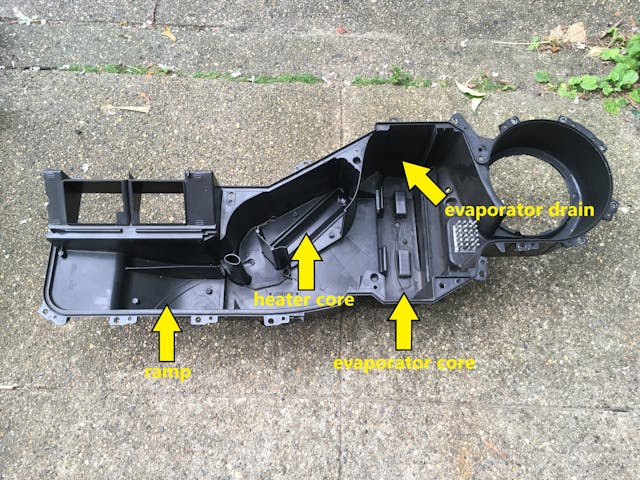
And it worked. Except that I didn’t realize that the blend door effectively blocks access to the heater core via the holes I’d drilled in the box. This oversight was because, by chance, when I pulled the “reference” heater box apart, the blend door stayed with the upper half, so it wasn’t included in my mental road map. So, I incorrectly thought that I had unimpeded access with the inspection camera and I could simply spray cleaner and water in the box and it would naturally soak and rinse the heater core.

Now, let me say that I’m not naïve. I’ve removed and cleaned the heater boxes in numerous vintage BMWs, and I fully appreciate the extent to which mouse odor eradication requires not simply emptying a can of Lysol into the box but disassembling it, removing the macroscopic source of odor (e.g., nest, bodies, and waste), and scrubbing every square inch before reassembling it. I understand that what I was doing with the truck was never going to be as thorough. I did, however, hope that by inspecting, spraying, and rinsing all affected areas, I could knock the smell down to a manageable level. But the fact that my effort missed inspection and cleaning of the heater core made it fatally flawed. Of course it smelled when I turned on the heat.
So, I again pressed my little $30 Amazon-purchased iPhone inspection camera into service. Sneaking it behind the blend door was challenging, but I eventually got the hang of it. Although the images were not nearly as dramatic as “the motherload and the mother” pics (the huge mouse nest and the desiccated carcass) from September, they showed that there were bits of wooly nesting material and clumps of waste on and around the base of the heater core. The inspection camera came with a little hook that you can screw over the tip. With some practice, I was able to use it to pull the wooly bits off.
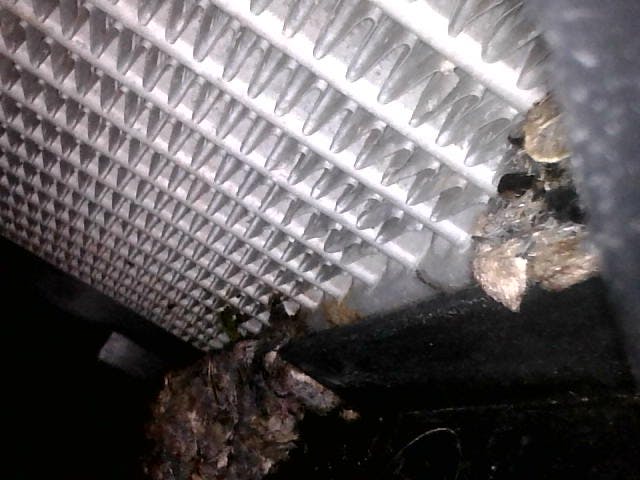
Since there wasn’t an obvious way to blast enzyme-based cleaner and copious quantities of rinse water behind the blend door, I opted for a can of Nextzett Klima Cleaner. This is a pressurized foaming evaporator core cleaner I’ve had good luck with inside my wife’s sometimes-smelly Honda Fit. It comes with a thin flexible tube meant to be threaded in past the blower fan or through the evaporator drain hole. I snaked it past the blend door and emptied the can onto the heater core. As I hoped, it foamed up, then followed gravity and naturally drained out the evaporator hole. Unfortunately, it didn’t knock the smell down nearly as much as I’d hoped.
I searched online quite a bit trying to find something I could use to both deliver the enzyme-based cleaner through a thin flexible hose as well as rinse with pressurized water. It was surprisingly difficult, as all the compressor spray wand attachments I found, such as the ones for applying undercoating, have a metal wand that’s too thick and stiff to reach behind the blend door.
I eventually settled on what Amazon lists as “Coilhose Pneumatics 602 600 Series Blow Gun with Siphon Tip” (like that’s something you’d ever search for). Basically, it’s a compressor-driven trigger-type air gun, like you’d use to blow crud out of old fuel lines or dust out of electronics, except that underneath it, it has a nipple that you can connect a hose to. It uses the venturi effect to suck whatever fluid the other end of that hose is submerged in. In addition, on the gun’s nose, it has a thin tube you can connect a second flexible hose to, as was essential for my snake-it-past-the-blend-door application. By having the end of the suction hose sitting in a mix of enzyme cleaner and water, and by taping the end of the delivery hose to the inspection camera, I was able to spray the diluted cleaner directly onto the heater core.
However, the blow-siphon gun’s performance was disappointing. It didn’t spray anything approaching garden hose or paint gun volumes. Instead, it sucked up a slug of fluid every five seconds, sprayed an atomized mist, then repeated the process. If I had to do it again, I’d try putting diluted cleaner in the reservoir of a small paint gun and figuring out how to attach a thin flexible hose to the tip.
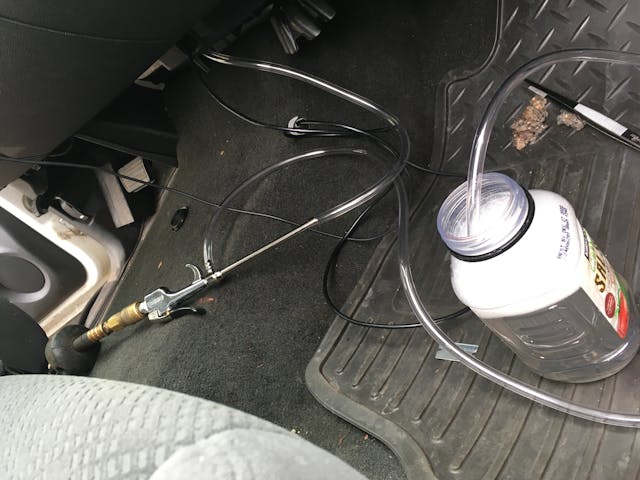
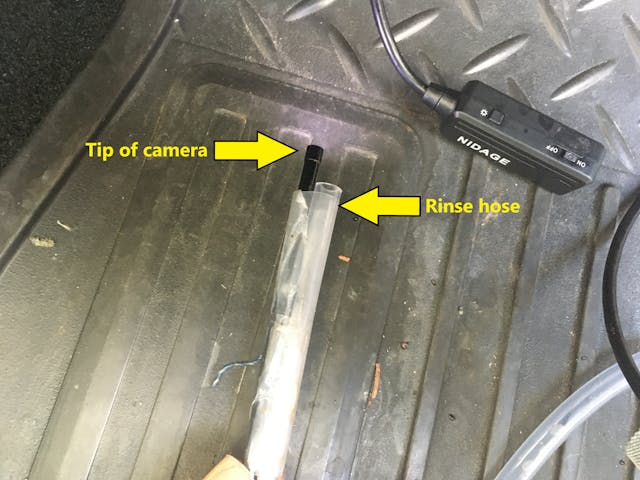
Because the blow-siphon gun’s performance was poor, I sought another tool for the delivery of garden hose—volumes of rinse water. This time I went to the local hardware store to actually lay eyeballs and hands on parts and found a right-angle garden hose to 1/4-inch compression fitting, the end of which was just small enough to put a flexible piece of tubing over. To turn the garden hose stream on and off, I bought a plastic shut-off valve. Screwing the two of them together did the trick. It was a combination I never would’ve hit upon by searching online.
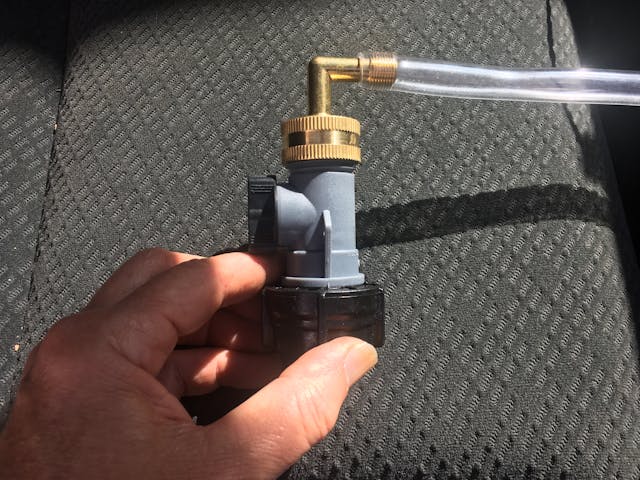
Using this combination of inspection camera and the two delivery systems, I first did the gross soaking and rinsing (the colonoscopy prep, if you will), then channeled my inner proctologist, hunting meticulously for little polyps on the heater core fins, soaking them with enzyme-based cleaner, then blasting them with decently pressurized water. I then did another systemic soak and rinse, monitoring the water running out the evaporator drain and verifying that it eventually ran clear.
And the result is … pretty good. With the volume of cleaning products that I’ve unloaded into this box, there’s no question that, when you open up the door of the truck, the first thing that hits you is the sharp smell of industrial disinfectant. The mouse smell is a subtler note, and it’s not overwhelming when the heat is on. This morning, it was about 40 degrees out, and I used the truck to run a load of old tires and cardboard boxes to the recycling center. I had to turn the heat on full to defrost the windshield and keep my toes warm, and the smell wasn’t close to offensive. We’re well past windows-down weather and into the-heat-can’t-come-on-fast-enough weather, and I’m not afraid of jumping in the truck. My wife would never ride eight hours in it with me to grab a car and tow it home, but that’s not something that was ever likely to happen anyway.
So, like last time, I’m calling it a success, which obviously means that last time it wasn’t a success, and that this time, it’s at best a qualified success.
I can live with that.
Ironically, my Lotus Europa now appears to need its heater box removed and cleaned. The car sat for 40 years before I revived it, and despite the inspection camera showing neither motherlode nor mother, it has a persistent rodent smell whenever the heater vents are open. Unlike the truck, however, the Lotus is a passion car, and its heater box can likely be removed in a few hours. I can’t say I look forward to the work, but I’m very comfortable with how I allocate my rodent-related time.
In fact, the more I think about it, the more it makes sense to devote all of my future columns to mouse-infested cars. But all of the cars have to begin with the letter “M,” so I get the alliteration in the title. The Mouse-Infested MG. The Mouse-Infested Morgan. The Mouse-Infested Mini. The Mouse-Infested Morris. And those are just the Brits. Let’s see… The Mouse-Infested Meteor. The Mouse Infested Matador. The Mouse-Infested…
Sorry. Don’t know what happened there. Must be the all the disinfectant.
***
Rob Siegel’s new book, The Best of the Hack MechanicTM: 35 years of hacks, kluges, and assorted automotive mayhem, is available on Amazon. His other seven books are available here, or you can order personally-inscribed copies through his website, www.robsiegel.com.
















Great bit,I have the same problem in a 2004 Silverado 2500. Curious if you drilled in a different location would it give you access to the heater core without going around the blend door? Thanks!